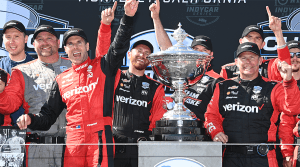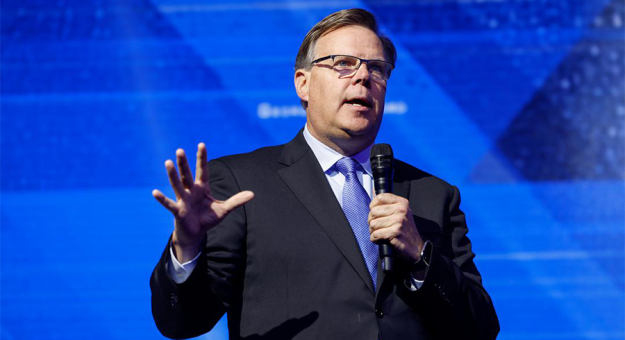With an improved engine and an expanded roster of teams, Chevrolet reclaimed the IndyCar Manufacturers’ Championship this season. It was the first time Chevrolet won the title since 2017.
Prior to that, Chevrolet won the title over Honda since it returned to the current NTT IndyCar Series in 2012-’17.
Honda began its four-year domination of the IndyCar Manufacturers’ Championship in 2018.
Jim Campbell, the U.S. Vice President for Performance and Motorsports for Chevrolet, reflected on the accomplishments of the IndyCar Series season.
“For Chevrolet, our history and heritage kind of starts with Indy,” Campbell said. “Louis Chevrolet and his brothers, they raced at Indianapolis, so here we are more than 100 years later and still racing.
“We love it. We absolutely love it. We couldn’t do it without great partners, so this year, our partners, 11 wins out of 17 races, so about two-thirds of the races, with Josef Newgarden, Scott McLaughlin, Pato O’Ward and Will Power bringing wins home, and 12 poles, which obviously count towards the manufacturer’s championship, as well. With Will Power, Scott McLaughlin, Pato O’Ward, Rinus VeeKay, Felix Rosenqvist and Josef Newgarden bringing home poles, as well, that really counted for valuable points.”
Campbell credited the strength of the Chevrolet teams, including one that returned to full-time competition, Juncos Hollinger, along with a return to success at Team Penske as reasons for Chevrolet’s edge over Honda.

Chevrolet teams included Team Penske, Arrow McLaren SP, Ed Carpenter Racing, A.J. Foyt Racing, Juncos Hollinger and Paretta Autosport.
“Those teams work together to get the testing and preparation done,” Campbell said. “Some of them scored specific manufacturer points, so that we’re thankful for. But they all contributed. So, a huge thank you,
Mark Stielow, Director, Motorsports Competition Engineering, oversees a partnership with Ilmor’s Paul Ray and Mario Illien. Rob Buckner is the IndyCar Program Manager for Chevrolet.
“It takes a lot of effort with our partners at Ilmor, our internal GM engineering team really put together a strong program for this year, and our team executed extremely well, so I’m very proud of the effort everybody put forward,” Stielow said. “The guys at Ilmor, Ray Gosselin, Paul Ray, Steve O’Connor, all those guys, we really dug deep, really in the offseason worked on a new strategy, utilized a lot of our tools with our driving simulator, worked with the teams to really come up with a more robust package for this season, and we got a lot of positive feedback from the drivers and the crew chiefs and everybody.
“But what we were working on paid dividends, and we got a lot of positive feedback on it.”
When Chevrolet returned to the NTT IndyCar Series in 2012, the United States-based automotive company wanted to focus on technology transfer. At that time, electrification was a science fiction like dream as car companies wanted to produce more horsepower more efficiently with less fuel consumption.
“Definitely on the engine side, Ilmor has been a great partner for us, but we’ve also taken some of those learnings and rolled them directly into a couple of our street cars,” Stielow said. “The Corvette Z06 is an example of that, and there’s some other areas where we have a lot of technology transfer between the simulation side of production, where we want to minimize the development time on the production side vehicles, but we also want to be able to come off the race trailer and go racing.
“We really have been sharpening our tool chains and technology transfer between motorsports and the production car side a lot. Before this job, I ran our driving simulator operations and our Hardware-in-the-Loop operations for GM, and we definitely have a lot of technology transfer in that space.”
General Motors has utilized advanced simulators to determine solutions that it can apply not only to the race track, but also the interstate highways and city streets.
“The simulator, that driving loop simulator, but we also do Hardware-in-the-Loop, so in the room next door we actually run hardware that feeds into the simulator,” Campbell explained. “That same simulator is down in the Charlotte area in Huntersville, N.C., the exact same simulator, so we get the learning on how to use that tool set back and forth, racing to production and vice versa.”
In 2023, Chevrolet hopes to maintain its advantage in IndyCar with the expansion of several of its key teams. Arrow McLaren SP is increasing to three cars with the addition of 100th Indianapolis 500 winning driver Alexander Rossi. McLaren F1 CEO Zak Brown has indicated McLaren is seriously considering a fourth full-time entry in IndyCar.
Juncos-Hollinger is also planning to increase to a second entry to go along with Callum Ilott.
Previously, Honda had the advantage based on the number of teams and number of entries on those teams, tilting the field in its favor.
Chevrolet is ready to counter.
“We’re a little bit less than half the field,” Campbell said. “We certainly have capacity to have half the field for sure, and we’re by contract obligated to go a little higher than that; up to 60 percent we need to be.
“That’s good and having great quality teams is the key. What we’ve found in every series in which we race, and our company is in eight different series around the world between Chevrolet, Cadillac and GMC, is that key partners are critical.
“With less testing time available, you’ve got to work together, and as Mark said, the simulation tools, really learning from one another, which was a tough thing to do. We were brought up in this industry to compete against one another, driver to driver, team to team, and what we find is when we get the right trust level, the learning side goes faster when we work good together in certain areas. Certainly, the teams have points of difference; they’re going to work hard on their own. But it’s good we’ll have about half the field next year.”
